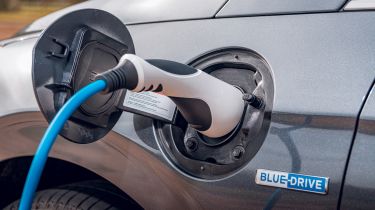Hyundai Ioniq Plug-In (2016-2022) range, MPG, CO2 & charging
Officially, the Hyundai Ioniq Plug-In will cover an astounding distance per gallon of fuel. Just make sure you keep the batteries charged
| Fuel economy | CO2 emissions | Electric range | Wallbox charge time |
|---|---|---|---|
| 257mpg | 26g/km | 32 miles | 2hrs |
The Hyundai Ioniq Plug-In has a relatively small battery for an electric range of only about 30 miles. However, that motor is boosted by a 1.6-litre petrol engine. Together, they help the Ioniq return astonishing fuel economy and ultra-low CO2 emissions – better than what the Toyota Prius Plug-In does.
Hyundai Ioniq Plug-In range, MPG & CO2 emissions
Officially, the Ioniq Plug-In will return 257mpg, emits 26g/km of CO2 and will cover more than 600 miles per tank of fuel. However, to achieve those figures you’ll need to charge the battery every night and have a very light right foot – or keep the car in ‘EV’ mode, which prevents the petrol engine starting for up to 30 or so miles.
Charge time
Charge your Hyundai Ioniq Plug-In using a conventional three-pin socket and it’ll take up to six hours to replenish the relatively small 8.9kWh battery. Use a 7kWh wallbox charger and the time comes down to a little over two hours.
The Ioniq Plug-In Hybrid comes with both a Type 2 charging cable for use with a wallbox or public charging points, and a three-pin cable for plugging into a domestic socket. That's more than can be said for plug-in hybrids from more prestigious brands, which often charge an extra £50 or so for the Type 2 cable.
